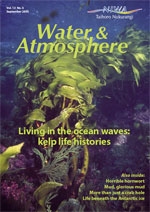PDF of this article (59 KB)

One of NIWA’s aims with this magazine is to contribute to science education in New Zealand. To this end we distribute Water & Atmosphere without charge to New Zealand high schools. Most of the magazine’s articles are assigned ‘Curriculum Connections’ to indicate which of the NZ NCEA Achievement Standards they can complement as a classroom resource. These links are assigned by Royal Society of New Zealand Teacher Fellows who are working during the year with NIWA scientists.
Remember that there is an Archive of past issues beginning with September 2000 (vol. 8, no. 3). All online articles include a pdf of the printed version and the articles are indexed via the website’s search engine.
Curriculum connections for this issue
| Article | Relevant NCEA Achievement Standards | Brief summary |
|---|---|---|
| Horrible hornwort threatens South Island lakes | Biology 90461 (2.5), 90718 (3.6) | This introduced aquatic plant has spread throughout the North Island and has been found in one South Island lake. |
| Where do those BIG fish come from? | Biology 90462 (2.6), 90717 (3.5) | A comparison of inanga populations in two rivers looks at the importance of rearing habitat in efforts to enhance the whitebait fishery. |
| Banded kokopu: sniffing out a good home | Biology 90462 (2.6), 90717 (3.5), 90718 (3.6) | A laboratory study investigates the role of bile acids as a pheromone that can help direct migrating native fish. |
| Restoring lake vegetation | Biology 90164 (1.4), 90461 (2.5) Science 90772 (2.3) | A study of three Waikato lakes describes the factors that can support or hamper efforts to improve water quality by restoring native vegetation. |
| More than just a crab hole | Biology 90460 (2.4), 90462 (2.6), 90716 (3.4) Science 90188 (1.3), 90766 (2.8) | Tunnelling crabs create labyrinths of burrows in mangroves. This study explains how these ‘ecosystem engineers’ affect sediment biogeochemistry. |
| Mud, glorious mud | Biology 90461 (2.5), 90718 (3.6) Science 90772 (2.3) | Sediments play a key role in coastal ecosystems, affecting photosynthesis and nutrient cycling. A study in the Firth of Thames has mapped the sediments and examined how aquaculture affects the seabed. |
| Living in the ocean waves: kelp life histories | Biology 90460 (2.4), 90463 (2.7), 90717 (3.5) Science 90772 (2.3) | True kelps have a two-phase, heteromorphic life cycle. Lab studies have helped determine the best environmental conditions for kelp reproduction. |
| Life beneath the ice | Biology 90716 (3.4), 90460 (2.4), 90461 (2.5) | NZ scientists participated in an Italian expedition to study seafloor communities in ice-scoured regions along the Victoria Land coast in Antarctica. |
